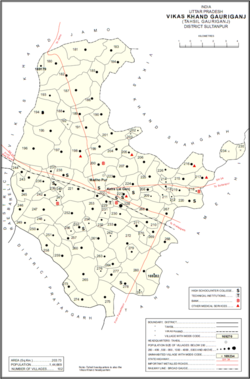Biswan, Amethi
Biswan
Biswān | |
|---|---|
Village | |
 Map showing Biswan (#248) in Gauriganj CD block | |
| Coordinates: 26°11′07″N 81°38′06″E / 26.185399°N 81.635101°E[1] | |
| Country | |
| State | Uttar Pradesh |
| Division | Faizabad division |
| District | Amethi |
| Area | |
• Total | 0.592 km2 (0.229 sq mi) |
| Population (2011)[2] | |
• Total | 353 |
| • Density | 600/km2 (1,500/sq mi) |
| Languages | |
| • Official | Hindi, Urdu |
| Time zone | UTC+5:30 (IST) |
Biswan is a village in Gauriganj block of Amethi district, Uttar Pradesh, India.[2] As of 2011, it has a population of 353 people, in 55 households.[2] It has no schools and no healthcare facilities and hosts both a permanent market and a weekly haat.[2] It belongs to the nyaya panchayat of Semuai.[3]
The 1951 census recorded Biswan as comprising 3 hamlets, with a total population of 193 people (104 male and 89 female), in 45 households and 45 physical houses.[4] The area of the village was given as 230 acres.[4] 1 resident was literate, a male.[4] The village was listed as belonging to the pargana of Amethi and the thana of Gauriganj .[4]
The 1961 census recorded Biswan as comprising 3 hamlets, with a total population of 183 people (95 male and 88 female), in 40 households and 40 physical houses.[5] The area of the village was given as 230 acres.[5]
The 1981 census recorded Biswan as having a population of 210 people, in 43 households, and having an area of 93.49 hectares.[6] The main staple foods were listed as wheat and rice.[6]
The 1991 census recorded Biswan as having a total population of 268 people (133 male and 135 female), in 47 households and 45 physical houses.[3] The area of the village was listed as 93.00 hectares.[3] Members of the 0-6 age group numbered 49, or 18% of the total; this group was 43% male (21) and 57% female (28).[3] Members of scheduled castes numbered 46, or 17% of the village's total population, while no members of scheduled tribes were recorded.[3] The literacy rate of the village was 43% (73 men and 21 women, counting only people age 7 and up).[3] 68 people were classified as main workers (66 men and 2 women), while 0 people were classified as marginal workers; the remaining 200 residents were non-workers.[3] The breakdown of main workers by employment category was as follows: 54 cultivators (i.e. people who owned or leased their own land); 13 agricultural labourers (i.e. people who worked someone else's land in return for payment); 0 workers in livestock, forestry, fishing, hunting, plantations, orchards, etc.; 0 in mining and quarrying; 0 household industry workers; 0 workers employed in other manufacturing, processing, service, and repair roles; 0 construction workers; 0 employed in trade and commerce; 0 employed in transport, storage, and communications; and 1 in other services.[3]
References
[edit]- ^ "Geonames Search". Do a radial search using these coordinates here.
- ^ a b c d e "Census of India 2011: Uttar Pradesh District Census Handbook - Sultanpur, Part A (Village and Town Directory)" (PDF). Census 2011 India. pp. 181–98. Retrieved 13 November 2021.
- ^ a b c d e f g h Census 1991 Series-25 Uttar Pradesh Part-XII B Village & Townwise Primary Census Abstract District Census Handbook District Raebareli (PDF). 1992. pp. xxiv–xxviii, 114–5. Retrieved 13 November 2021.
- ^ a b c d Census of India, 1951: District Census Handbook Uttar Pradesh (49 - Rae Bareli District) (PDF). Allahabad. 1955. pp. 96–7. Retrieved 13 November 2021.
{{cite book}}: CS1 maint: location missing publisher (link) - ^ a b Census 1961: District Census Handbook, Uttar Pradesh (44 - Sultanpur District) (PDF). Lucknow. 1965. pp. xl–xli. Retrieved 13 November 2021.
{{cite book}}: CS1 maint: location missing publisher (link) - ^ a b Census 1981 Uttar Pradesh: District Census Handbook Part XIII-A: Village & Town Directory, District Rae Bareli (PDF). 1982. pp. 90–1. Retrieved 13 November 2021.

